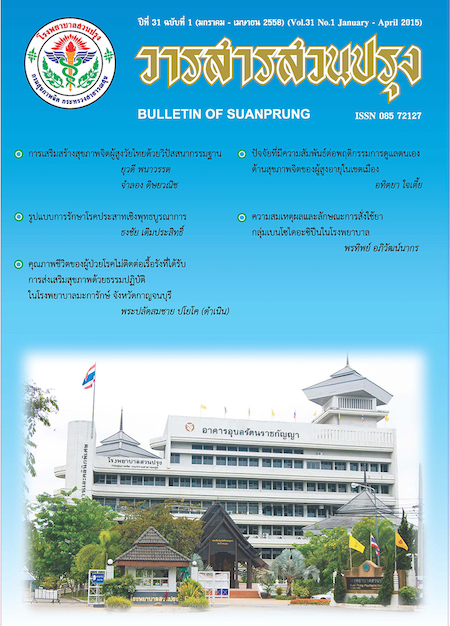The rationale and the pattern of benzodiazepines prescription in hospitals
Main Article Content
Abstract
Objective To study the rationale and the pattern of benzodiazepines (BDZs) prescription in hospitals Methods We conducted a retrospective study of prescription pattern of benzodiazepines and evaluated three aspects of the rationale for prescription of BDZs (indications, dosage, and duration of treatment) in outpatients during April to June 2012 in 12 hospitals using descriptive statistics Results 2,030 participants (3,958 prescriptions), mostly elderly (29.8%), were diagnosed with other anxiety disorders (F41), depressive episodes (F32) and schizophrenia (F20) (17.8%, 9.3% and 8.5% respectively). BDZs are often prescribed by psychiatrists in psychiatric hospital, by internists and general physicians in general hospital, and by general physicians in community hospitals. However, 6.1% of BDZs are prescribed by nurses in community hospitals. The percentage of patients receiving more than one type of BDZs is 24 to 35%. BDZs are prescribed over 6 months and 1 year (33.3% and 25.0% respectively). Rationale for indications on the prescription is 22.3%. Most non-rationale indication is mood (affective) disorders (F30-F39) (22.5%). Common reasons for non-rationale prescription are insomnia, stress, and anxiety (24%). Rationale for dosage is 97.2%. However, there is still some non-rationale dosage in the elderly. Rationale for duration of treatment on the prescription is 47.2%. Three aspects of rationale for prescription of BDZs (indications, dosage, and duration of treatment) are 9.3%. Conclusion At all levels of hospital, BDZs prescriptions were found to be high non-rationale when evaluated by "Criteria for rationale for prescription of benzodiazepines".
Keywords: Benzodiazepines, The rationale , prescriptionArticle Details
บทความหลังผ่านการปรับแก้จากกองบรรณาธิการแล้ว เป็นลิขสิทธ์ของวารสารจิตเวชวิทยาสาร โรงพยาบาลสวนปรุง กรมสุขภาพจิต กระทรวงสาธารณสุข ห้ามเผยแพร่เพื่อประโยชน์ทางการค้าโดยไม่ได้รับอนุญาต แต่อนุญาตให้เผยแพร่บทความดังกล่าวเพื่อประโยชน์ทางการศึกษาแก่ประชาชนทั่วไป ทั้งนี้กองบรรณาธิการไม่จำเป็นต้องเห็นด้วยกับบทความหรือข้อคิดเห็นใดๆ ที่ปรากฏในวารสารสวนปรุง
